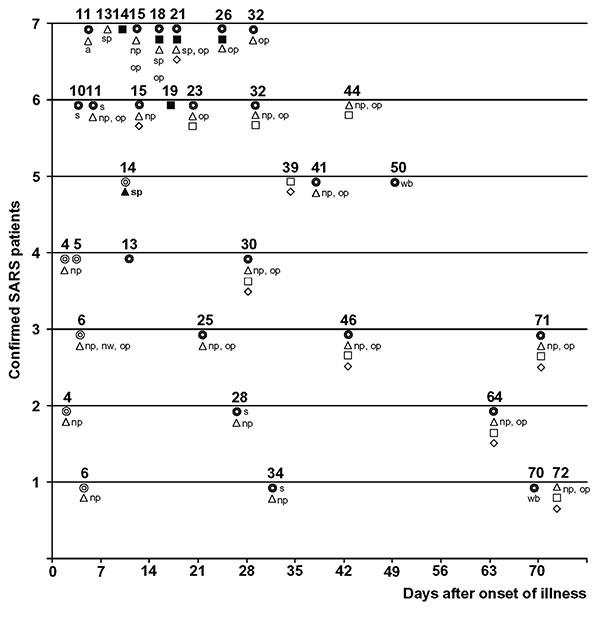Volume 10, Number 2—February 2004
THEME ISSUE
2004 SARS Edition
SARS Transmission
SARS-associated Coronavirus Transmission, United States
Figure

Figure. Detecting severe acute respiratory syndrome–associated coronavirus (SARS-CoV) RNA by reverse transcriptase–polymerase chain reaction (RT-PCR) and SARS-CoV antibodies by enzyme-linked immunosorbent assay (ELISA) in clinical specimens from seven confirmed SARS case-patients, United States, 2003. Circle within circle: blood specimens (same symbol represents both whole blood and serum when both specimens are collected and results are entirely concordant. s, serum; wb, whole blood (symbols are labeled s or wb if either blood or serum was collected). Blocked symbols denote SARS-CoV–positive specimens by ELISA. ∆: respiratory specimens (include np, nasopharyngeal swab; nw, nasal wash; a, nasal aspirate; op, oropharyngeal swab; sp, sputum). □: stool. ◊: urine. Blocked symbols denote SARS-CoV–positive specimens by RT-PCR.
1Members of the SARS Investigation Group: J. McLaughlin (Alaska Division of Health); M. Romney, A. Kimura (California Department of Health Services); D. Dassey, B. Lash, D. Terashita (California-Los Angeles County Health Department); S. Klish (California-Orange County Health Care Agency); S. Cody (California-Santa Clara County Health Department); S. Farley (California-Contra County Health Department); S. Lea (California-Marin County Health Department); R. Sanderson (Florida Department of Health); J. Wolthuis (Georgia Division of Public Health); C. Allard (Mississippi Department of Health); B. Albanese (New Mexico Department of Health); B. Nivin (New York City Department of Health and Mental Hygiene); P. McCall, M. Davies (North Carolina Department of Health); M. Murphy, E. Koch (Ohio Department of Health); A. Weltman (Pennsylvania Department of Health); H. Brumund (Virginia Department of Health); C. Barton (Utah Department of Health); K. Whetstone (Southwest Utah Public Health Department); W. J. Bellini, S. Bialek, J. A. Comer, S. Emery, R. Helfand, T. Hennessy, A. James, A. LaMonte, E. C. Newbern, S. Scott, L. Simpson, A. Siwek, C. Smelser, L. Stockman, X. Lu, D. White (Centers for Disease Control and Prevention).